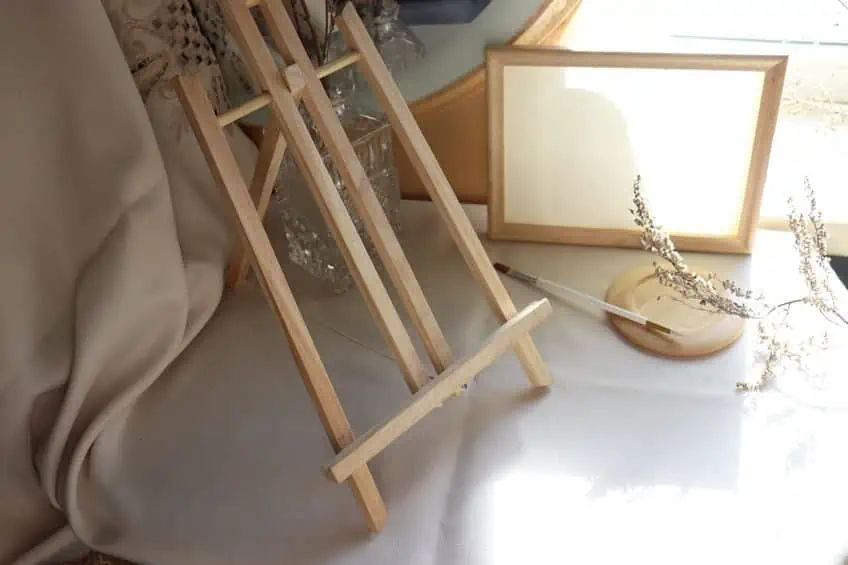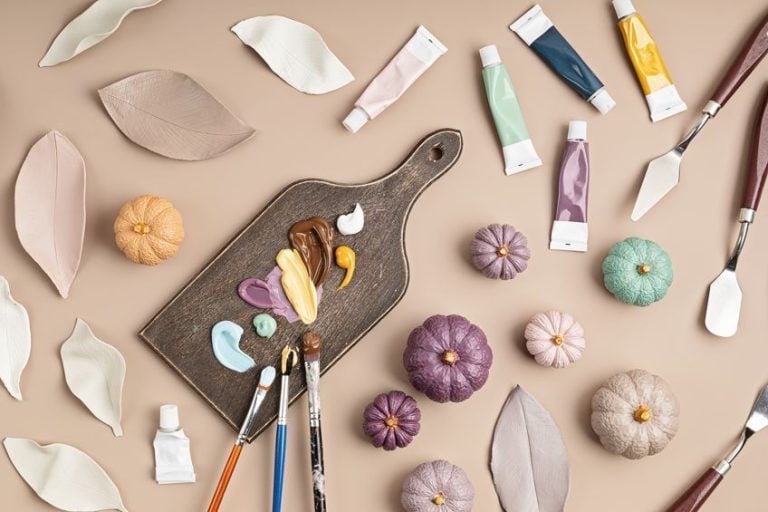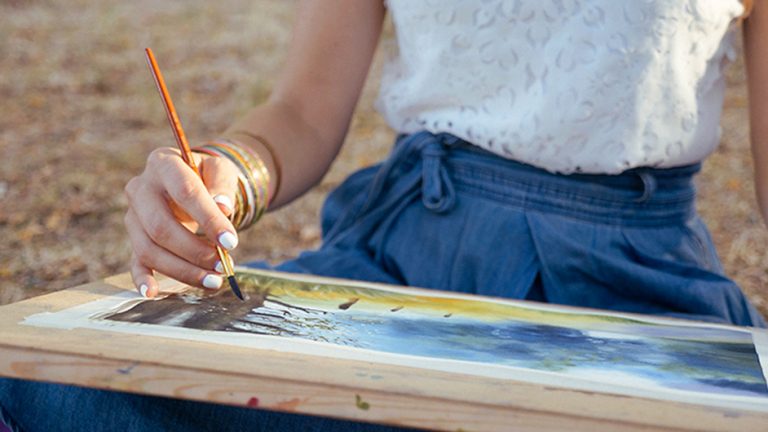Types of Easels – What Are the Best Kinds of Easels for Drawing?
This post may contain affiliate links. We may earn a small commission from purchases made through them, at no additional cost to you.
An art easel is an important piece of equipment for any artist to make use of. Easels have many different benefits and come in large varieties to suit a wide range of needs. Whether you need a compact and portable tabletop easel for painting, a large easel for bigger canvases, or just a basic wooden easel there is an easel that is ready to meet your requirements. This article is all about easels, how and why they are used, and what you need to consider before investing in your first easel!
Table of Contents
An Easel Definition
An easel is a frame or stand that is used to hold an artist’s work upright as they paint or draw. The most common and more traditional easel is a wooden easel, but it can also be made using materials such as metal or plastic. Since easels support a painting while an artist works on it, they are a crucial tool for many artists who have found that they prefer painting in an upright position rather than hunching themselves over a table. An easel is sometimes also used to display a completed painting.

If you are an artist, you’ll be glad to know that easels are great for your posture, and they also allow you to paint with wider ranges of motion than just using your wrist. When using an easel, you have the entirety of your arm and body available for use while you paint. Some easels also allow you to change the angle you are painting at, which can be helpful when checking for glare or applying a glaze or varnish.
When working with an easel you can easily step away from your canvas and look at your artwork from a distance. This is something you can’t do if your artwork is lying flat on a desk or table. Standing away from your art helps you better assess the proportions and composition of your piece as a whole.
If you buy a more portable easel, you can even experiment with painting outdoors (en plein air painting) or at any other location aside from your home or studio.
What to Look for in an Easel
Many artists go a long time without using an easel. Sometimes the first time an artist encounters an easel is in a tutoring setting of some sort, such as an art class or college lesson. Some artists find that even once they have tried an easel that it simply isn’t suitable for them. Everyone is different and if you are thinking of getting an easel you will need to think about what easel is best for you based on what you need.

Before we talk about the types of easels available on the market, we are going to talk about what you should consider before deciding on the type of easel you want to get. Do you want to use your easel in places other than your home or studio? If you are only using your easel at home, how much space do you have for it, and will you move it around your home? Do you paint with a lot of energy and movement or do you need/prefer to sit down? What medium do you work with?
There are many questions you need to ask yourself when choosing the best easel for your needs. We go into more detail about each of these things below to help you decide what factors are most important to consider before choosing an easel type.
Easels come in many various shapes and sizes and will offer different benefits to different artists.
What Is Your Painting Style?
Painting using an easel allows greater freedom of movement and many people find the experience much easier than in other painting positions. Using an easel is especially freeing for artists who have a loose and energetic painting style. Artists with an energetic style, however, should be sure to choose a sturdy easel. Any easel that is too lightweight will not be able to withstand energetic movements and may move or even topple completely, which can ruin your painting. On the other hand, if you do not paint with a lot of movement or energy and prefer smaller, more delicate strokes you can definitely get away with using a lightweight easel design.

How Big or Heavy Are Your Paintings?
Each easel will have a maximum height and weight that it can accommodate for. You will need to consider how large and heavy your paintings are before you settle on an easel you would like to purchase. Remember to consider your easel weight and height restrictions in relation to how you prefer to work.
For example, if you only work with small canvases but you would like to stand as you paint, you will need to ensure that the lower canvas support on your easel can extend high enough to hold your painting at a suitable height.
You might not think that any artwork could be too heavy for an easel, but the size is a considerable factor that contributes to an artwork’s weight. Also, if you are a mixed-media or collage artist you should be sure to get an idea of what your average painting weighs so that you can be sure that the canvas you settle on will be suitable for your needs. If you regularly work with heavier canvases then you should invest in a heavier easel with a high weight tolerance.
Where Do You Want to Use Your Easel?
When choosing an easel to suit your needs you must think about where you will be painting. Do you want to be able to pack up your easel and paint outdoors on a whim, or will your easel have a designated place in your studio? Perhaps there’s something in between where you will be working at home but you have limited space and need to move your easel around quite a bit. All these different environmental conditions will affect the type of easel you should choose.

If you are painting outdoors you will want to choose something that is portable and compact, while if you have a studio, you can choose something sturdier and less portable. If you have limited space and are working from home you will want to find an easel that is semi-portable and readily collapsible but still sturdy. Alternatively, you might opt for a small easel such as a table easel for painting if you tend to work in a communal space such as a public classroom or your family’s dining/living room.
What Medium Do You Use?
The mediums you work with will also affect the type of easel you will want to choose. For example, if you are a watercolor artist, you will not want to have an easel that is fixed at a steep vertical angle. Steep vertical angles may cause your paint to run while keeping it at a more horizontal angle will allow smooth, easy application of paint washes. Horizontal tilting is also a useful feature for artists who want to varnish their work because it allows them the ability to apply varnish in smooth, even layers.
Horizontal tilting can even be used to tilt your canvas forward if your painting process spans multiple sessions.
This will help you keep dust off of the surface of your painting. Even if you are using an easel for drawing with pastels or other mediums, the ability to tilt your canvas forward will also prevent dust from landing on your artwork. You can also use the ability to move and tilt your easel to provide easier access to specific parts of a canvas. This allows you to find the easiest or most comfortable position to work where you would like to and may assist you in performing a variety of painting techniques.
What Are the Different Types of Easels?
Once you have considered what you are looking for in your easel it is time to start browsing them for yourself. You will find many brands of easels online and at art supply stores but you won’t necessarily understand what type of easel you are considering at any given time. Below we outline the most common types of easels so that you can easily distinguish between them all. Understanding the difference between all the different kinds of easels allows you to weigh out the benefits and downfalls of each easel for yourself.

A-Frame Easel
A-frame easels are also referred to as “Lyre easels”. You can recognize an A-frame easel because it has a triangular structure. The front of the easel looks has the canvas supports and column arranged in a manner that makes it look like an “A”. The easel is supported like a tripod, with the main frame being balanced at the back with a single leg.
These easels are suitable for beginner- to intermediate-level artists who want an affordable, compact, and portable solution.
- Suitable for small and medium paintings
- Lightweight and portable
- More stable than a portable easel
- Can be used en plein air and in a studio
- More affordable than an H-frame easel
- Compact and folds up for easy storage
- Suitable for beginners and intermediate artists
- May not be suitable for professional artists
- Not suitable for mediums like watercolor paint which require fewer vertical angles
- Less stability than some other easels available on the market
- No built-in storage compartments for art supplies
- Not suitable for larger canvases

H-Frame Easel
H-frame easels also get their name because of the way that the column and frames are arranged. The frames and columns of an H-frame easel look like an “H”, which helps them stay more stable than A-frame easels. Their robust structure is suitable for sedentary use as they are not easy to deconstruct and move around. They can, however, be adapted to accommodate canvases of many different sizes and can be used at different angles. H-frame easels sometimes come with shelves or drawers attached to the lower canvas supports, which can be used to store art supplies.
H-frame easels are suitable for artists who need a sturdy studio easel that can accommodate different-sized canvases and can be tilted to fewer vertical angles.
- Can handle a range of canvas sizes, from small to large
- Usually comes with a shelf or drawer to store art supplies
- Sometimes has wheels to make movement around a studio easier
- Suitable for beginner to professional artists
- Sturdy and stable
- A great investment for artists with the space for it
- Can be tilted to more horizontal angles for working with mediums such as watercolor
- Not portable
- Not easy to deconstruct
- You would need to set aside a dedicated space for it
- More expensive than an A-frame easel

Single-Mast Easel
Single-mast easels have a very simple construction which allows them to be very compact, easy to store, and quite portable. These easels are not very sturdy, however, and are a very basic entry-level easel for artists who desperately need the convenience of a single-mast easel over the versatility and practicality of other easel types.
If you are concerned about your easel price, single mast easels are affordable and suitable for small- to medium-sized canvases, but do not come with storage drawers or shelves for art supplies.
- Lightweight, compact, and portable
- Suitable for small- to medium-sized canvases
- Affordable
- Can be tilted to more horizontal angles for working with mediums such as watercolor
- Not sturdy
- Doesn’t have any storage drawers or shelves for art supplies
- Not suitable for larger canvases
- Not suitable for professional artists

Giant Easel
These easels are a very heavy-duty option for artists who regularly work with really large or heavy artworks. They are extremely sturdy to support the weighty canvas frame. As far as easel price goes, giant easels are among the most expensive due to the sheer size of their structure.
Giant easels are even less portable than average H-frame easels are, and will definitely need a dedicated space as they are not easy to deconstruct or move around.
- Suitable for large and extra-large canvases
- Very sturdy
- Difficult to deconstruct and move around
- Expensive
- Heavy
- Will need a large dedicated space

Tabletop Easel
Tabletop easels are great for artists who have limited space, want good portability, and prefer working while seated at a table. These easels are suitable for small to medium-sized canvases and usually have some kind of drawer or shelf attached to them. A tabletop easel for painting is sturdy and compact, which means that it will withstand use and still not take up much space. They are available in A-frame and H-frame variations and tend to be quite affordable.
Artists that tend to prefer a table easel for painting are artists who like to paint in various locations or at a desk, or who simply don’t have a large amount of space for working on their art.
- Compact, lightweight, and portable
- Suitable for small to medium-sized canvases
- Can be tilted to more horizontal angles for working with mediums such as watercolor
- Available in A-frame and H-frame variations
- Usually comes with a shelf or drawer to store art supplies
- Affordable
- Good for artists who prefer to sit while they work, or who enjoy working at a table
- Not suitable for artists who prefer to stand
- Doesn’t support larger canvas sizes

Bench Easels
Bench easels are named after the fact that they are a combination of an easel and a bench. They are suitable for artists who enjoy painting en plein air and who enjoy sitting as they paint. Many artists who give demonstrations choose to use bench easels since they are compact and portable.
This means that not only do you get to take your easel with you, but you also don’t have to carry around an extra chair!
- Has an attached seat
- Lightweight and portable
- Usually has a shelf or drawer for storage of art supplies
- Can be tilted to more horizontal angles for working with mediums such as watercolor
- Can be tricky to find
- Not very sturdy
- Quality brands might be pricier than other easel types
- Takes up a fair amount of space if used indoors
- Not suitable for artists who prefer to stand and paint

Display Easel
Display easels are not designed to be used when actually creating paintings, but are instead purely for displaying artworks. They are easily collapsible and portable, although they are not nearly as stable as artists’ easels.
Many artists, shops, and galleries use display easels to showcase completed art in a simple, convenient, and artful way.
- Affordable
- Lightweight, compact, and portable
- Good for displaying artworks
- Comes in a variety of shapes and sizes
- Not suitable for use as an artist’s easel
- Not very sturdy
- Can’t be tilted

Children’s Easel
Children’s easels are usually very adjustable so that they can grow along with children and last a good number of years before needing to be replaced. Some models are even double-sided so that two children can share the same easel without butting heads. Other models have chalkboards, dry erase boards, or magnetic boards built-in for when children don’t have canvases, paper, or panels to work on.
Another option is to get an easel with a replaceable paper roll that dispenses from the top of the board!
- Great for children who enjoy painting
- Height can usually be adjusted to accommodate a child’s growth
- Different brands have different add-ons such as chalkboards or space for a replaceable paper roll
- Affordable
- Not as sturdy as an artist’s easel
- Only suitable for children
- Most brands don’t allow for tilting

A Summary of Easels for Drawing
In the table below, we have briefly summarized the points from the discussions above. Here, you will be able to easily compare the important parts of the different types of art easels.
| Easel Type | Suitable Canvas Sizes | Portability | Sturdiness | Can Be Tilted |
| A-Frame Easel | Small to medium canvases |
| Less sturdy than an H-frame easel but sturdier than a single-mast or French easel | ✘ |
| H-Frame Easel | Small to large canvases |
| Very sturdy and stable | ✔ |
| Single-Mast Easel | Small to medium canvases |
| Not sturdy | ✔ Most brands can be tilted |
| Giant Easel | Large to extra-large canvases |
| Extremely sturdy | ✘ Most brands can’t be tilted |
| Tabletop Easel | Small to medium canvases |
| Fairly sturdy | ✔ Most brands can be tilted |
| Bench Easel | Small to medium canvases |
| Fairly sturdy | ✔ Most brands can be tilted |
| Display Easel | Small to large canvases depending on the easel |
| Not sturdy enough to be an artist’s easel and is strictly for display purposes | ✘ |
| Children’s Easel | Small to medium canvases |
| Fairly sturdy but children must be taught not to topple it | ✘ Most brands can’t be tilted |
Now that we have provided an easel definition, and described the various types of easels available it should be a lot easier for you to think about which art easel is best suited for your needs! Whether you want a wooden easel, a small easel, a large easel or an easel for drawing there is a wide range of easels readily available that are ready to meet your needs. Be sure to ask yourself the right questions when choosing your easel so that you don’t make a large investment only to be disappointed that it doesn’t meet your expectations or requirements. Being sure about what you need out of your easel can save you lots of money and regret later down the line!
Frequently Asked Questions
Where Do I Position My Easel?
You always want to position your easel where there will be enough light hitting your canvas. Ideally, the light that hits your canvas should be even and unobstructed. Make sure that the light is not so direct that it causes glare. Also, do your best to ensure that there is room behind your canvas so that you can step back and get a good look at it from a distance. In other words, avoid placing your canvas somewhere with a wall directly behind it.
Why Is an Easel Called an Easel?
The word easel has its origins in the Dutch word for donkey. The word ezel, meaning donkey, was used to refer to artists’ easels because they carried and held an artist’s canvas much like a donkey would carry luggage or other loads. Over time the word ezel progressed into the word easel which we still use today.
Can You Sit and Paint at an Easel?
Some people prefer to stand and paint at an easel because it gives them more freedom of movement and it is easier for them to step away from the painting and look at it from a distance. However, you can definitely choose to sit and paint at an easel if you prefer it! Many people prefer to sit at their canvas for various reasons. Some people find that standing makes it harder to get steady strokes or that it is simply uncomfortable for them. Other people have disabilities that prevent them from standing at an easel altogether. You can do whatever works best for you, and there is a range of easels that can accommodate artists who prefer to sit and paint.
What Easel Is Best for a Beginner?
Single mast easels are the best easels for beginners. They are less sturdy than some other easels but make up for this by being affordable and easy to store. Single mast easels can be readily found online and at most art supply stores. If you are a beginner and want something a bit more sturdy but still portable, consider getting a standard A-frame easel instead.
Megan is a writer and researcher who graduated from the University of Cape Town with a degree in Social Sciences, specializing in Psychology and Environmental Science. Her passion for knowledge and leaving a positive impact has fueled her current work in conscious and sustainable growth in Southern Africa. Megan’s love of nature has also led her to train as an animal behaviorist. She works part-time training and rehabilitating dogs. Megan is interested in the physical and psychological effects of colors in our environment on our mood and well-being. In addition, she is concerned with how art and creativity have been an integral part of human society. Megan van Schoor has been writing blog posts on the topics of painting, drawing, and color theory for acrylgiessen since 2021.
Learn more about Megan van Schoor and about us.







